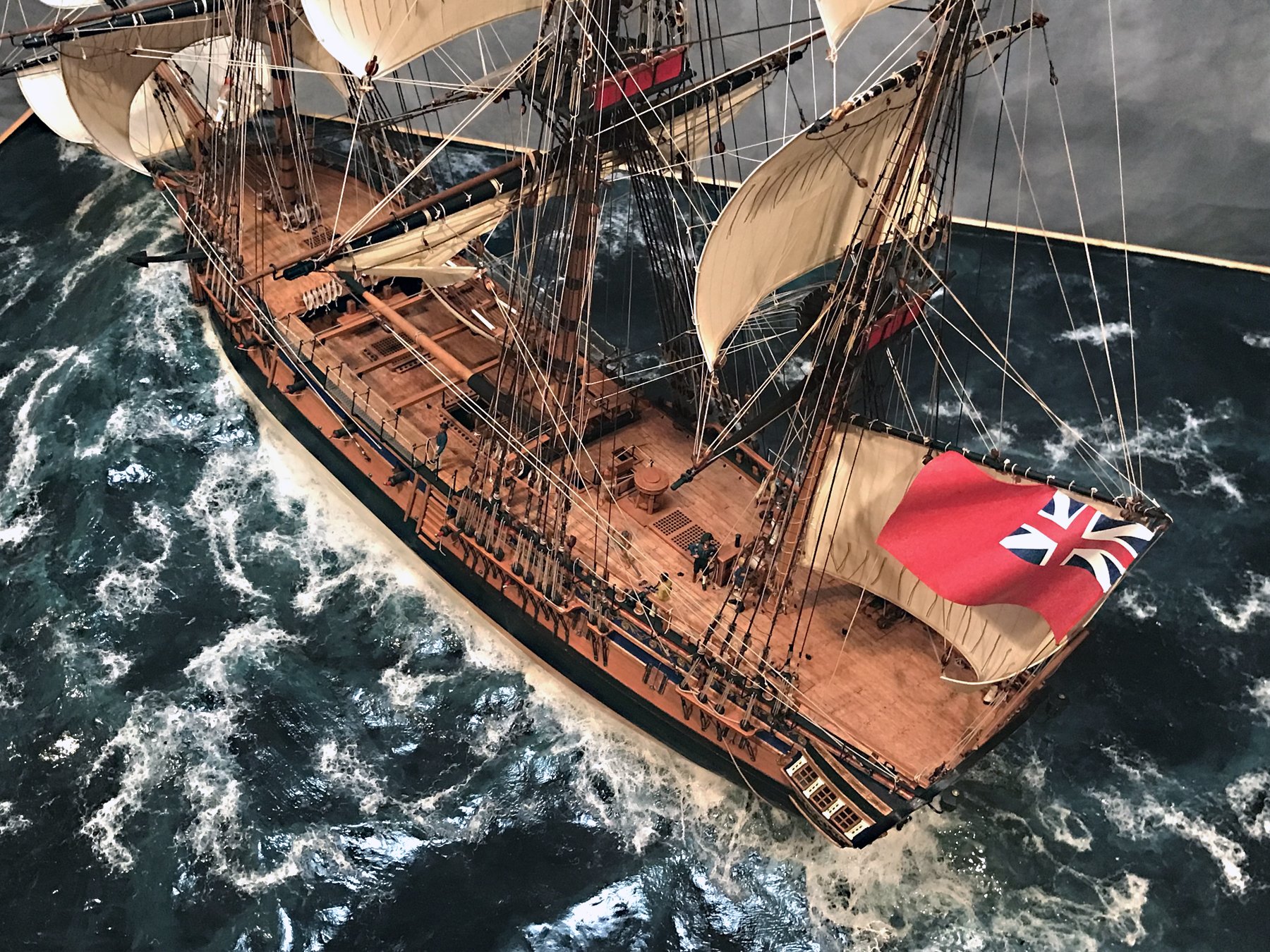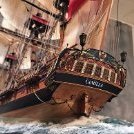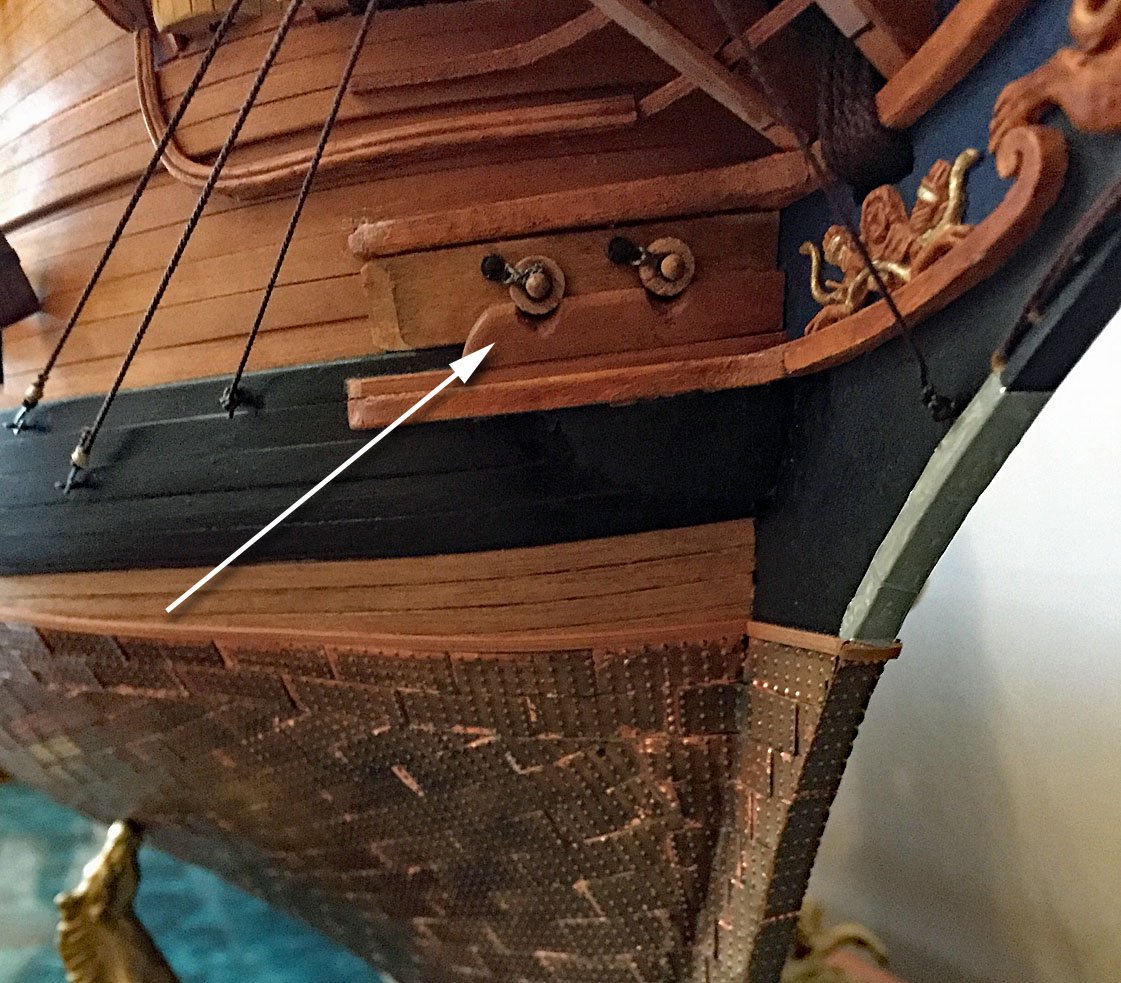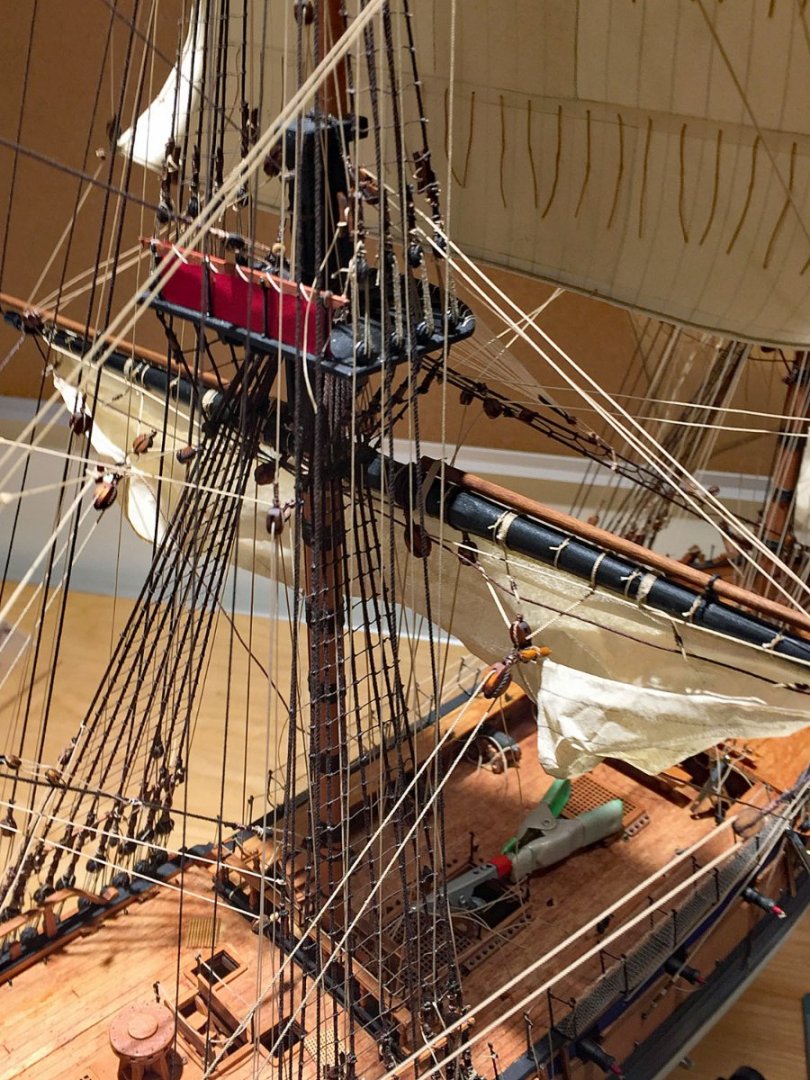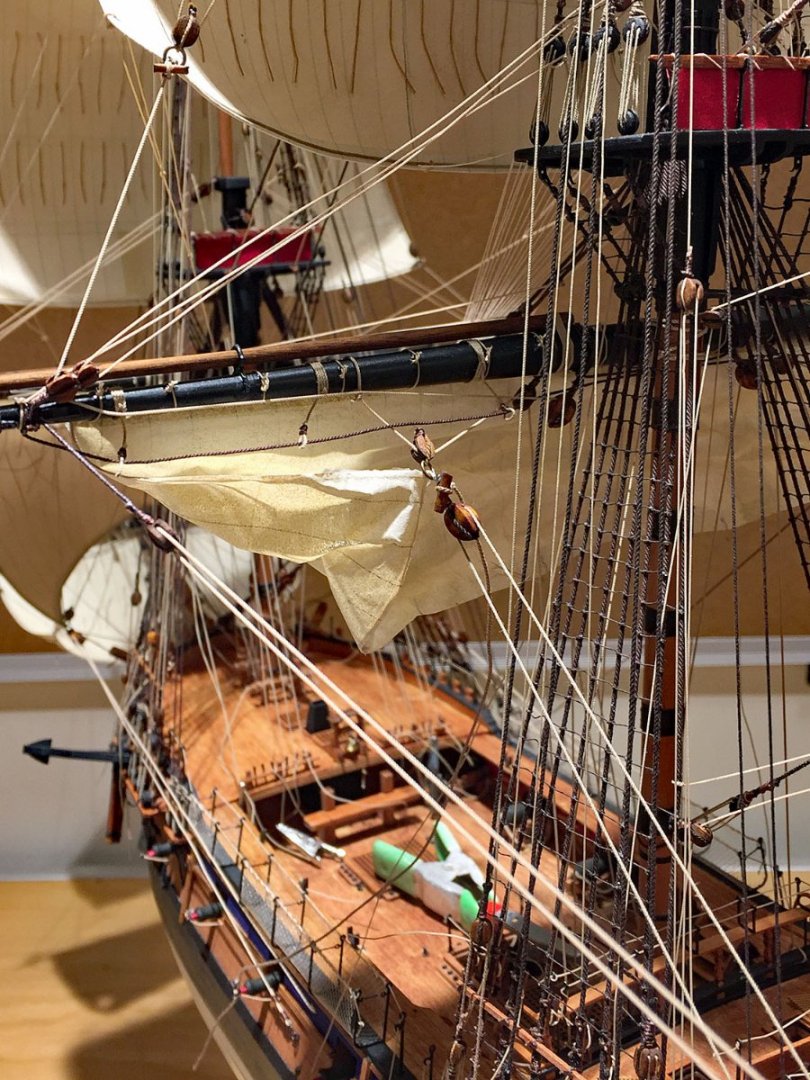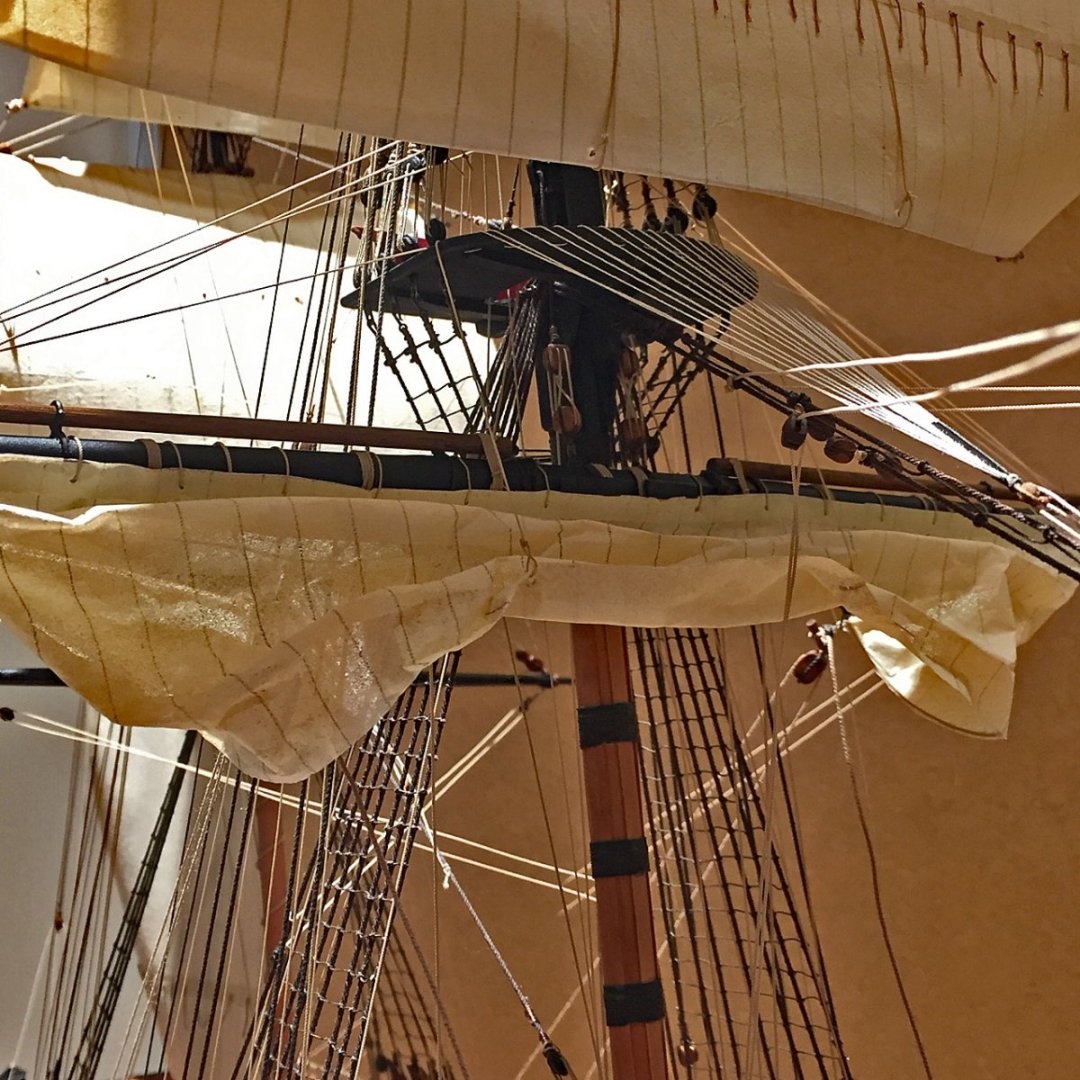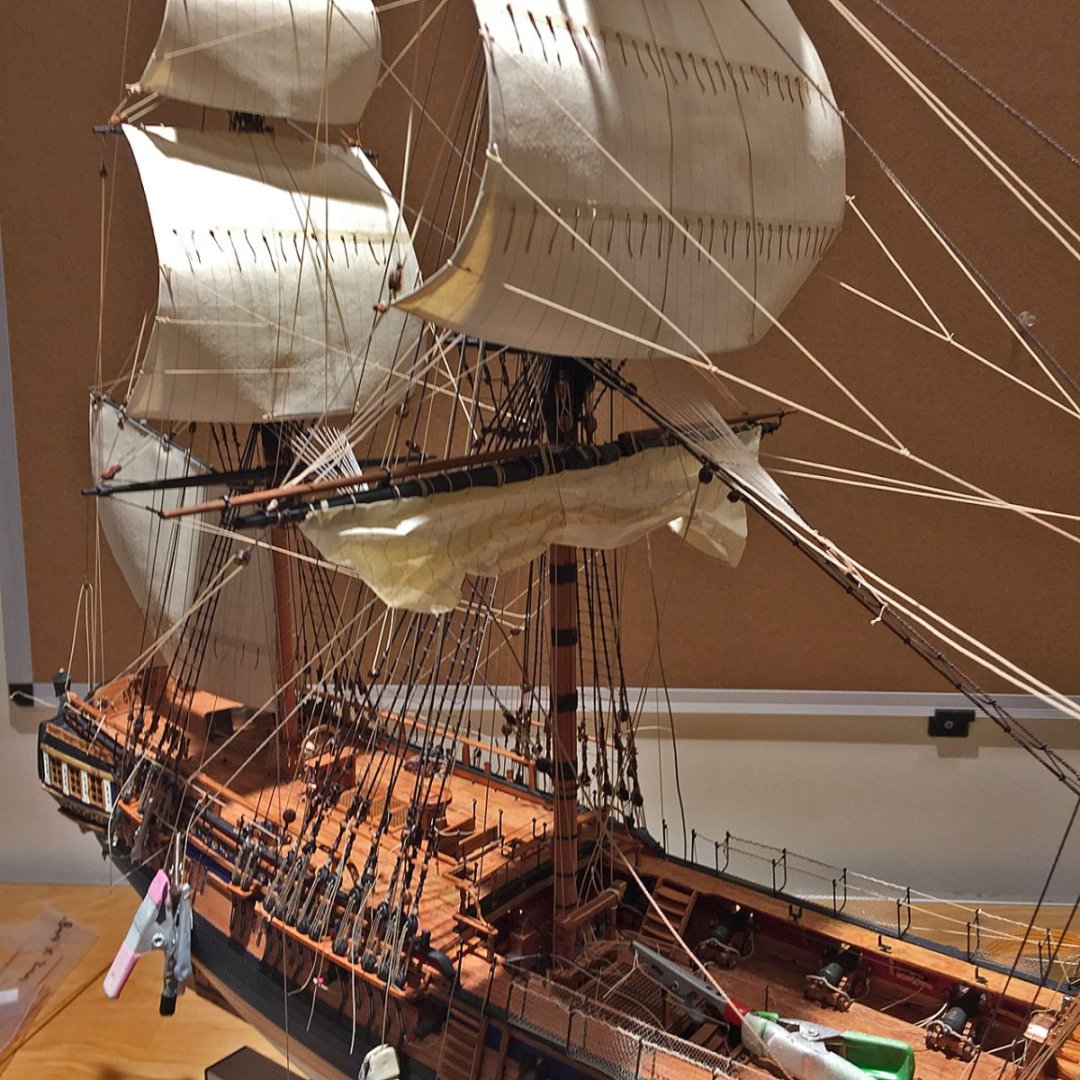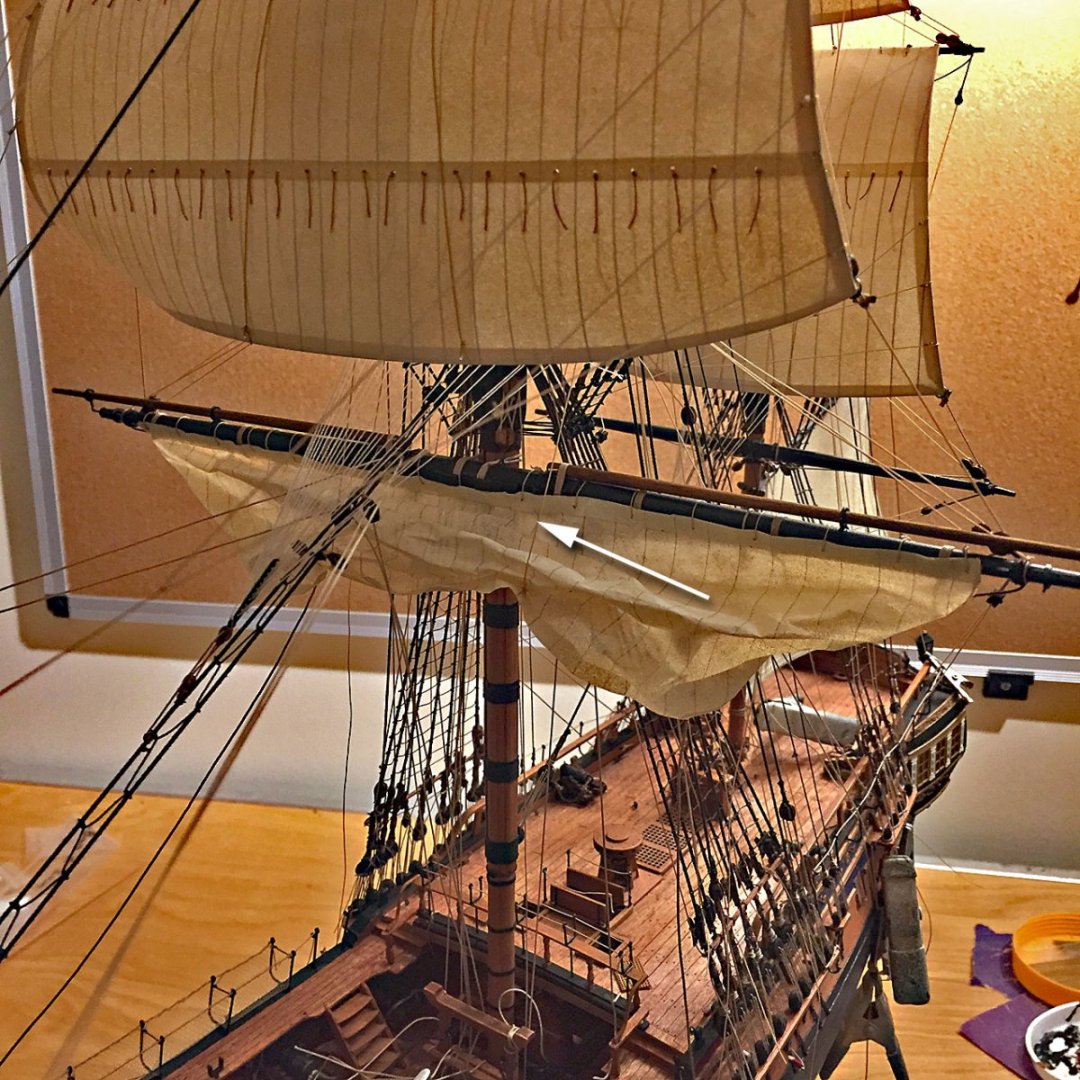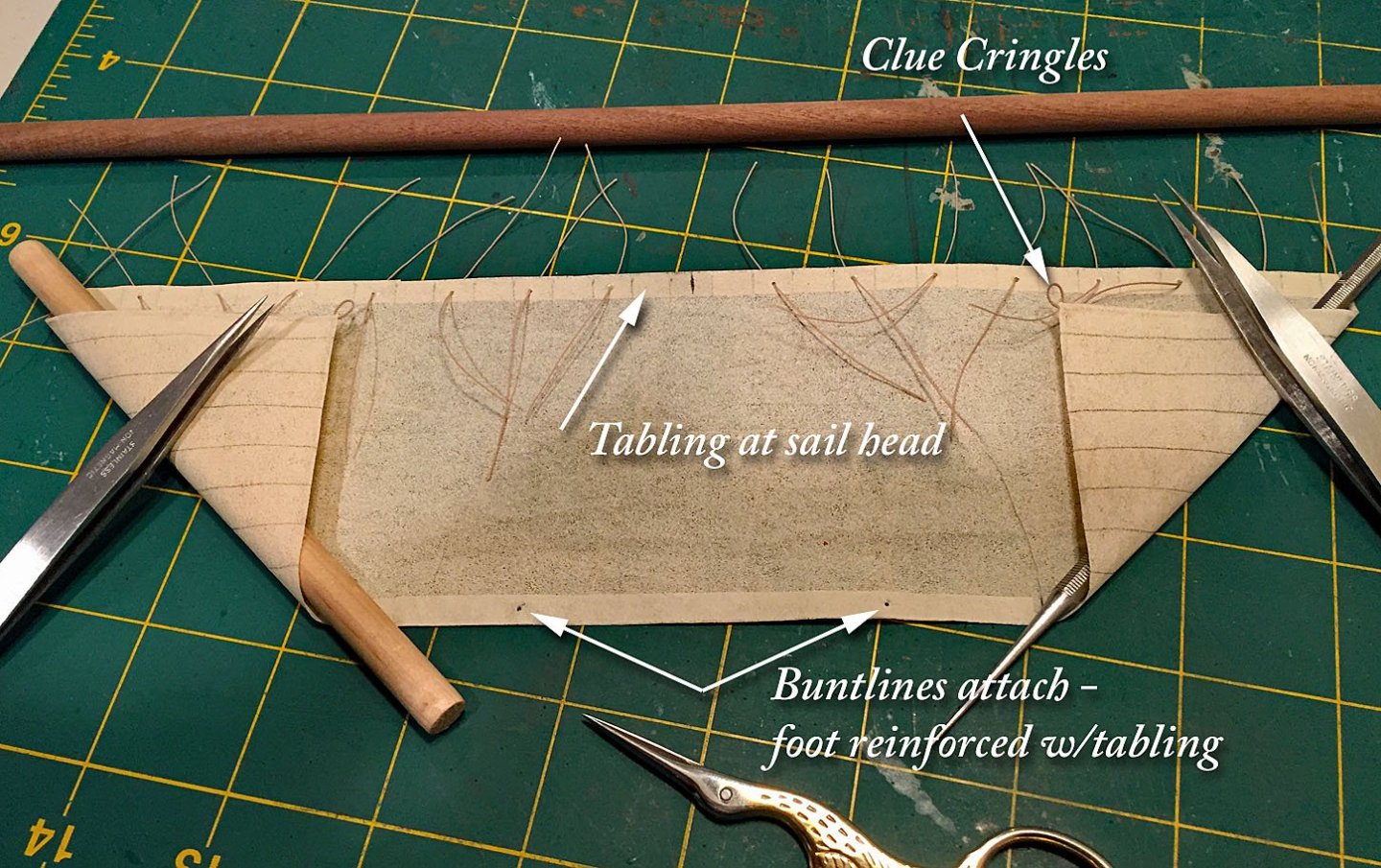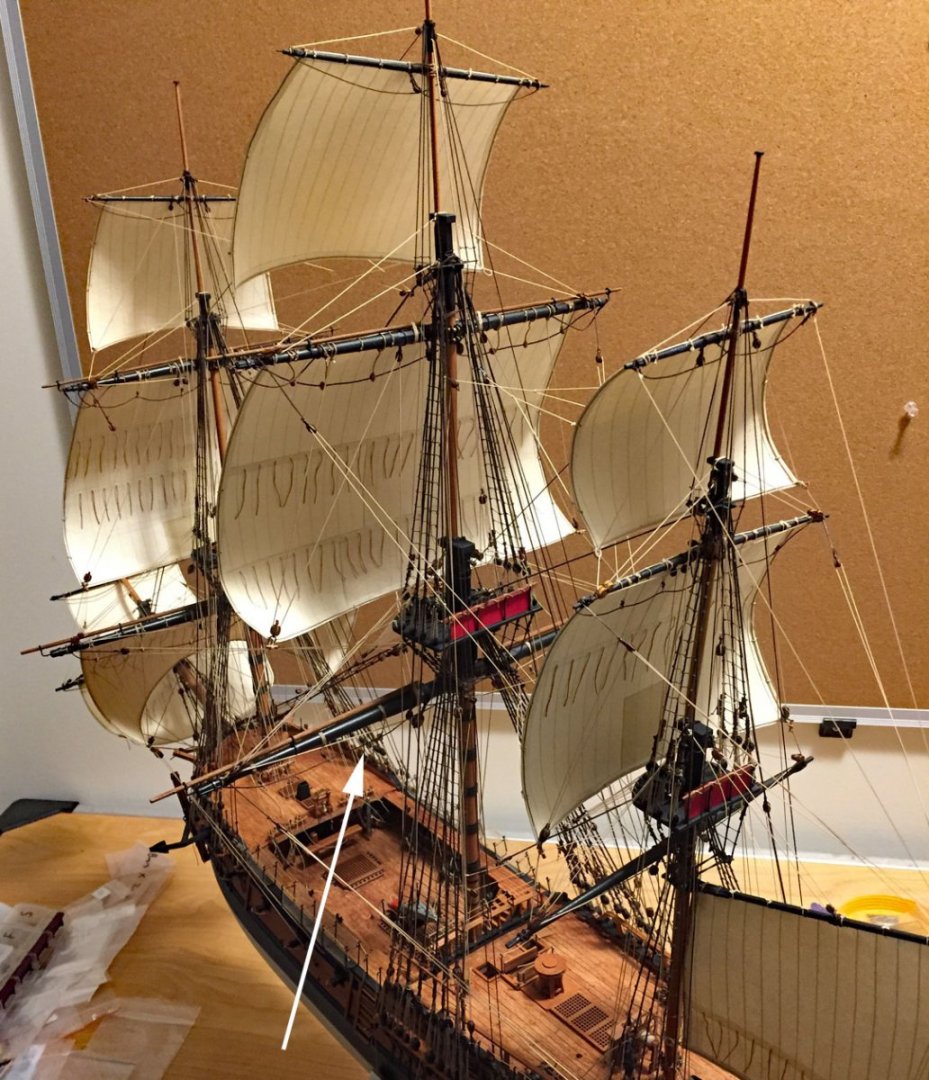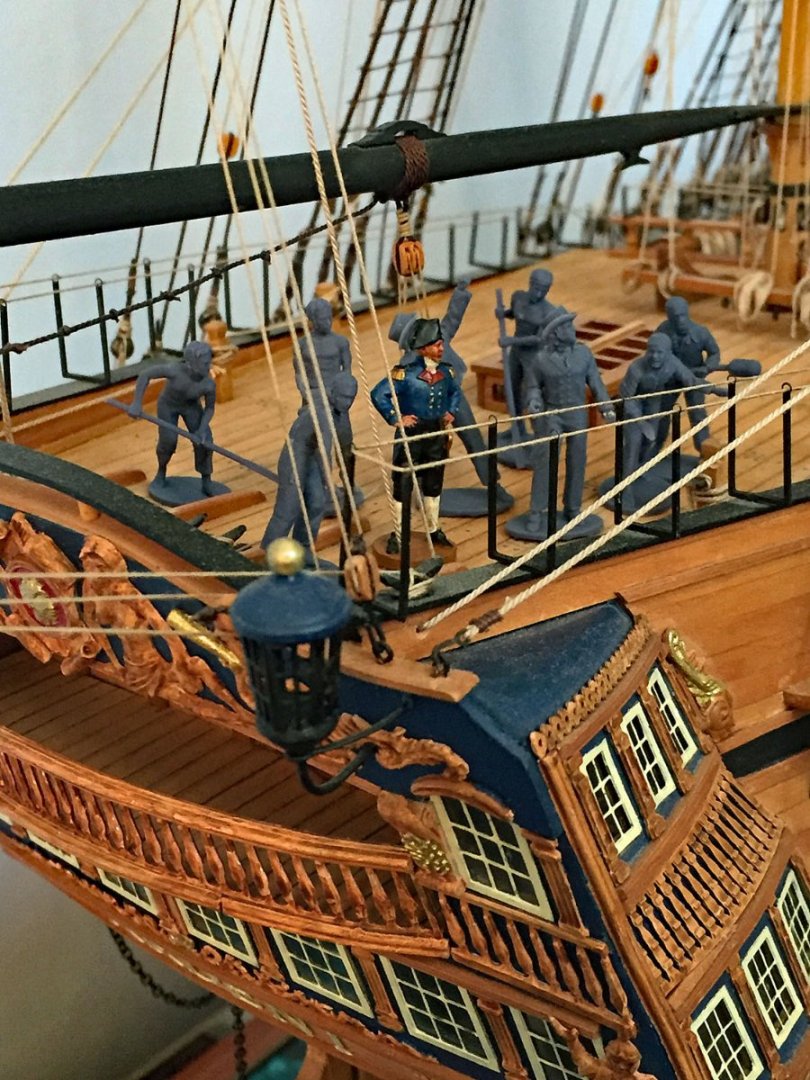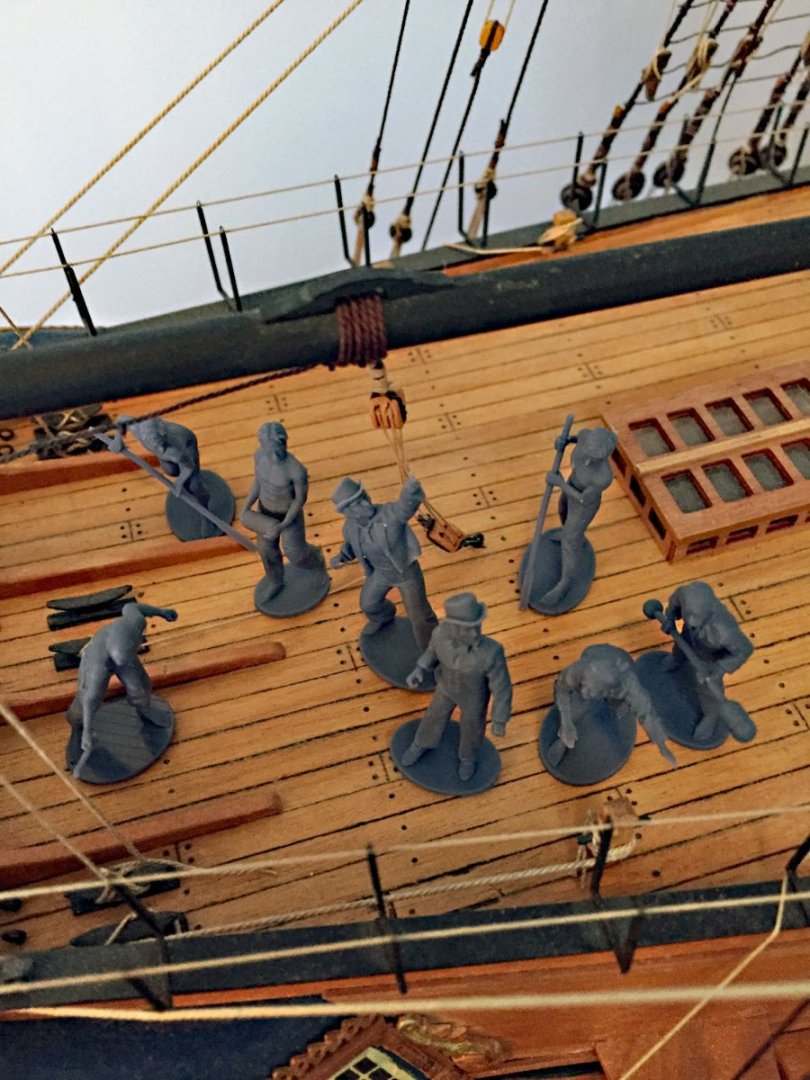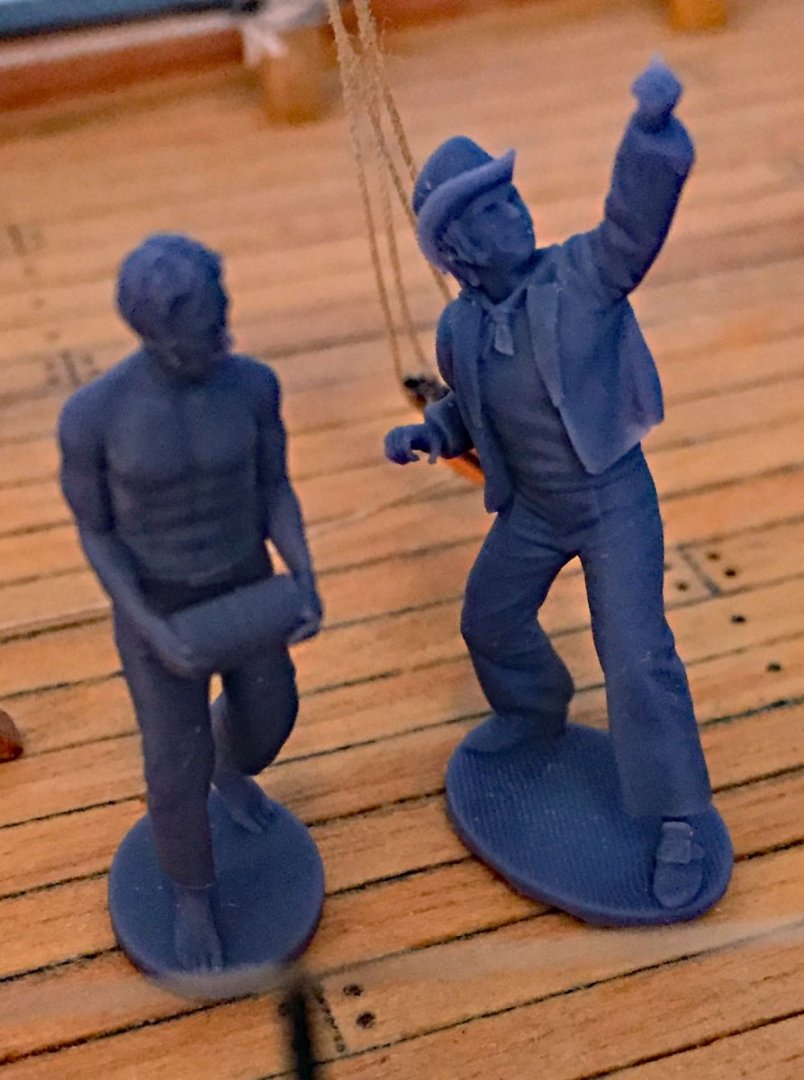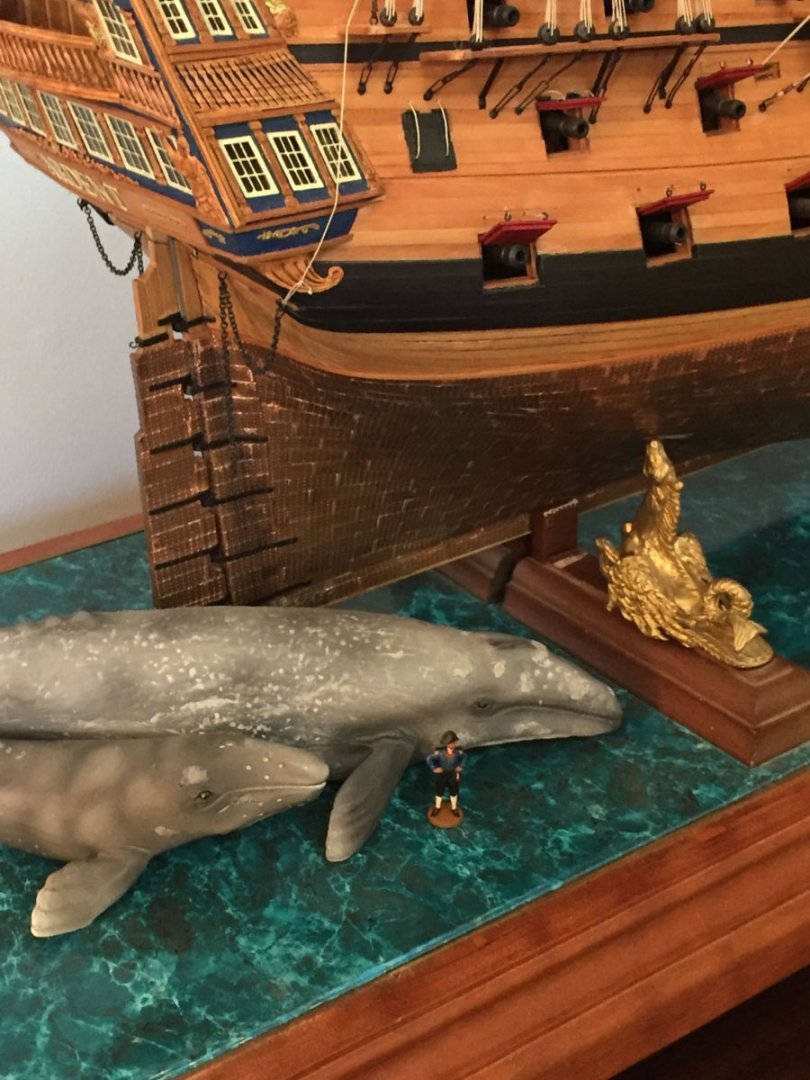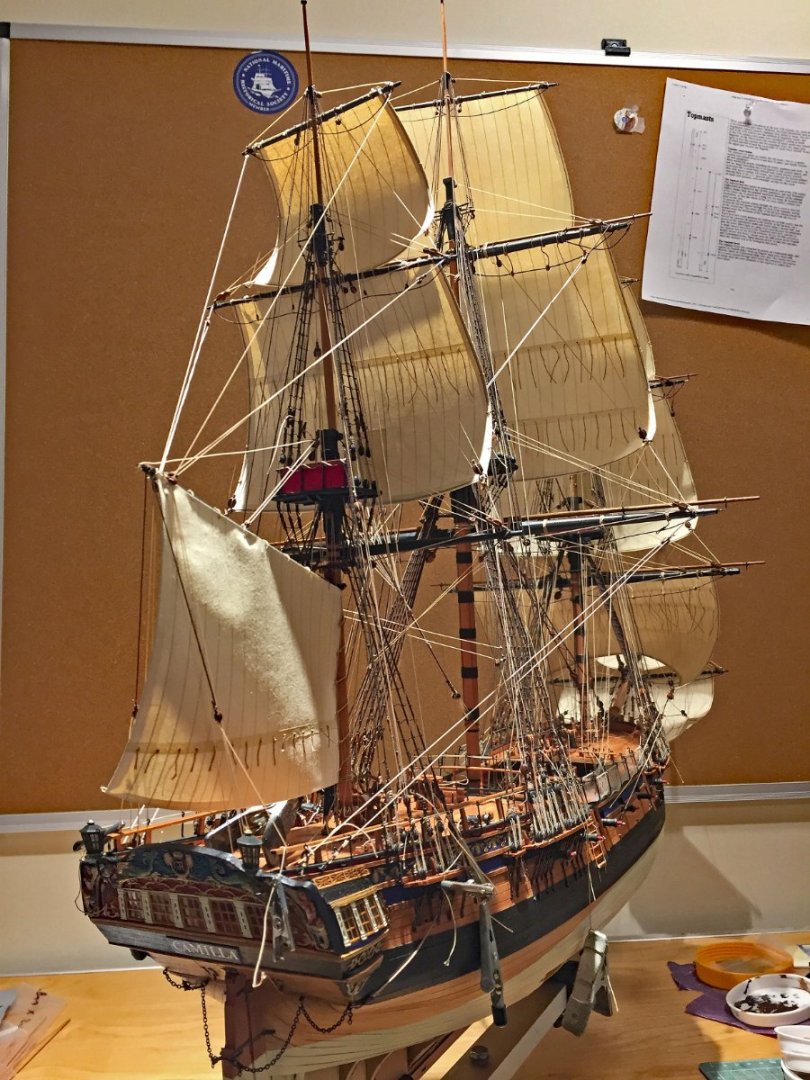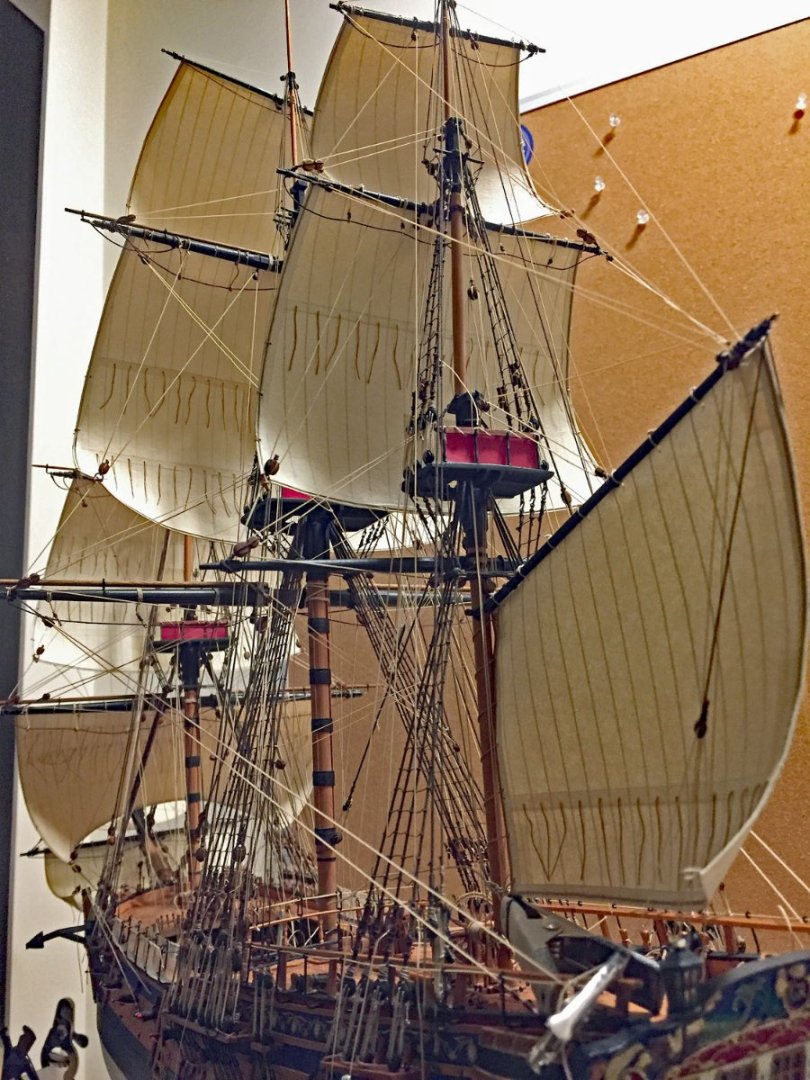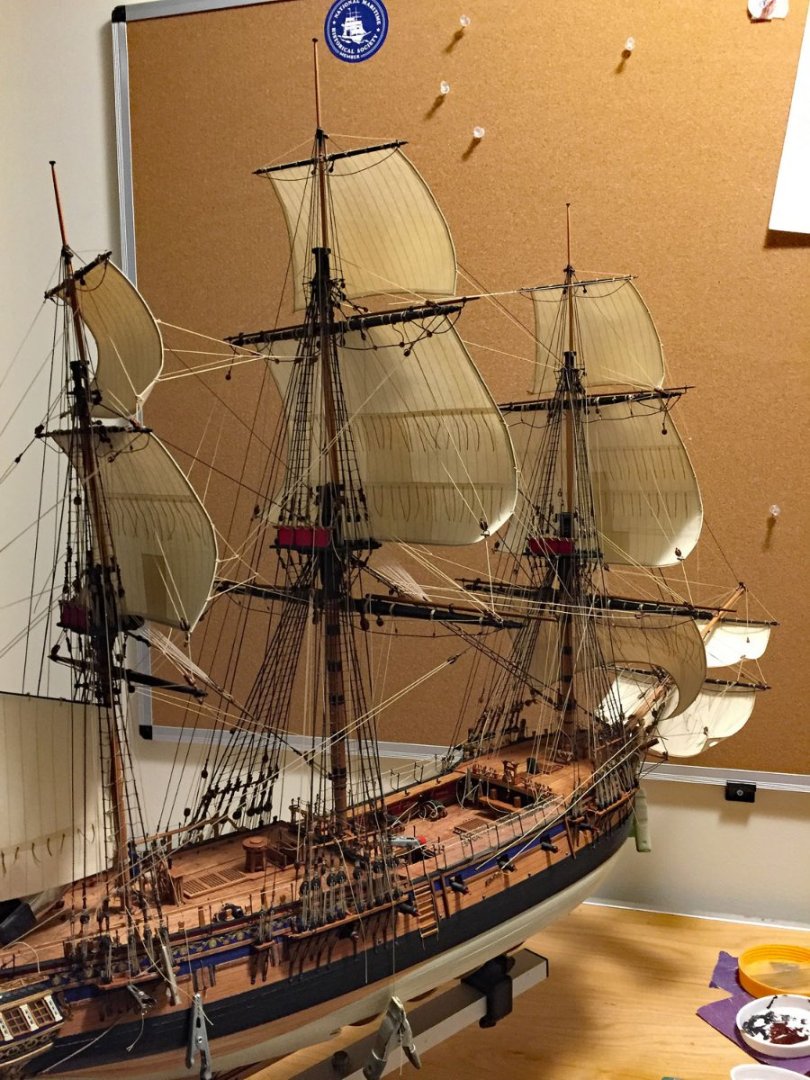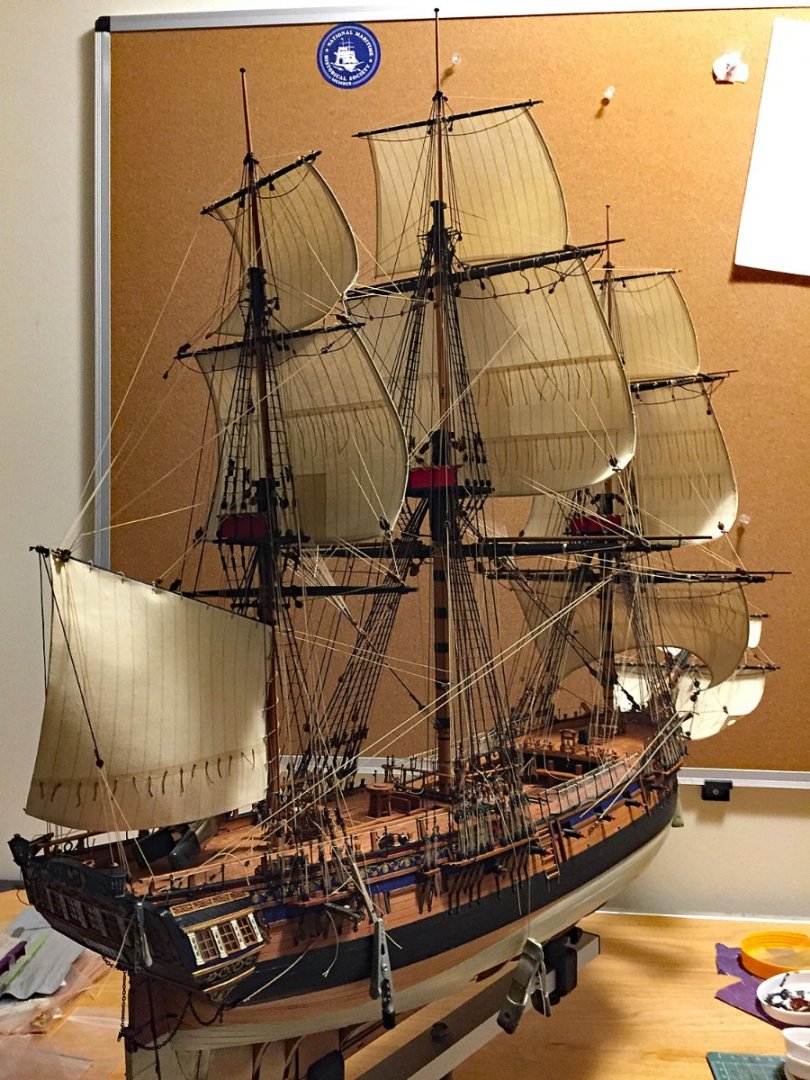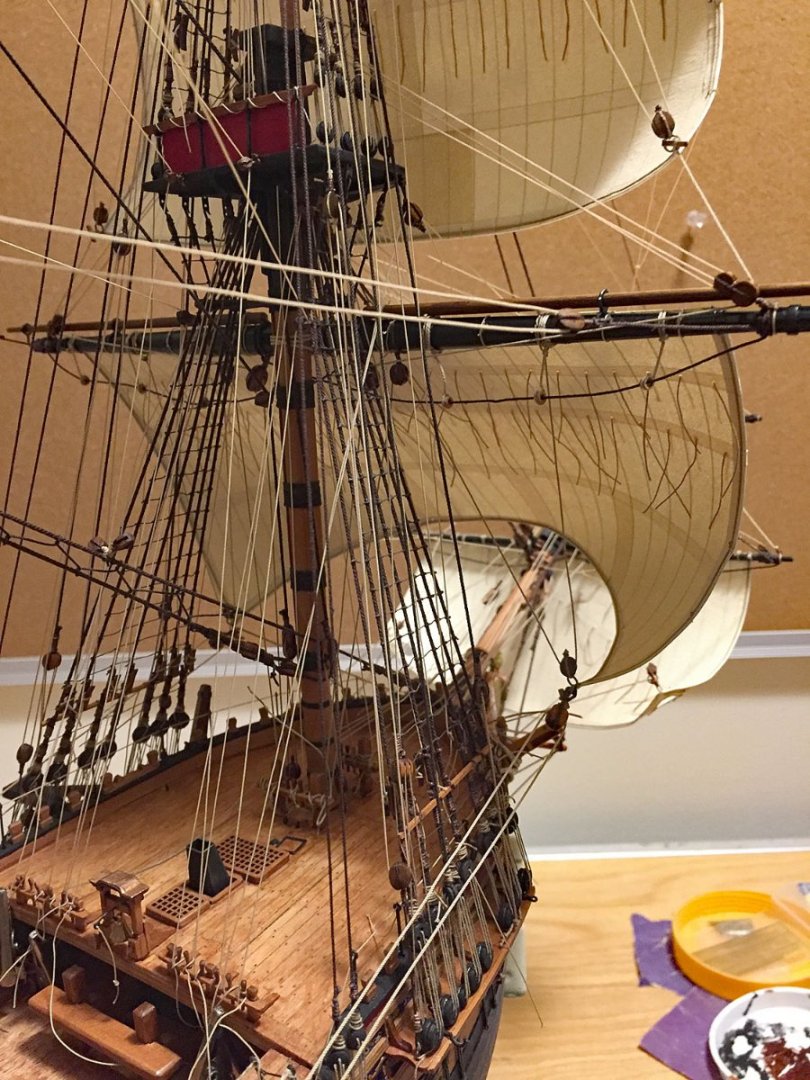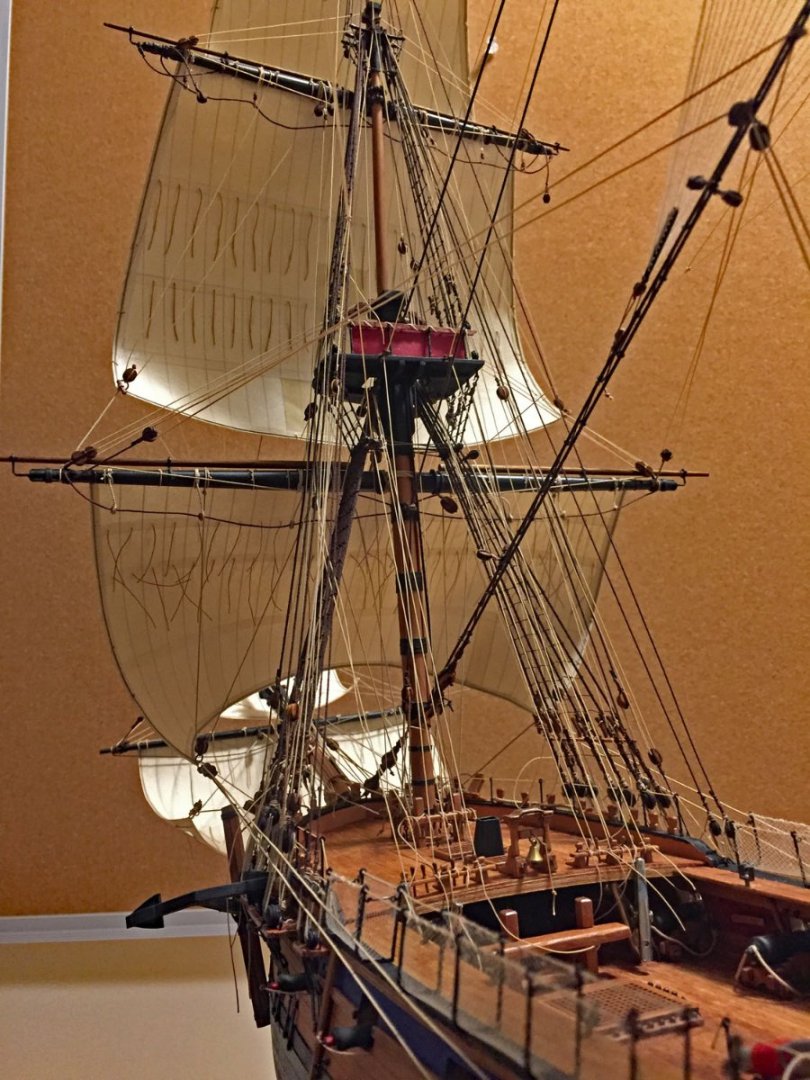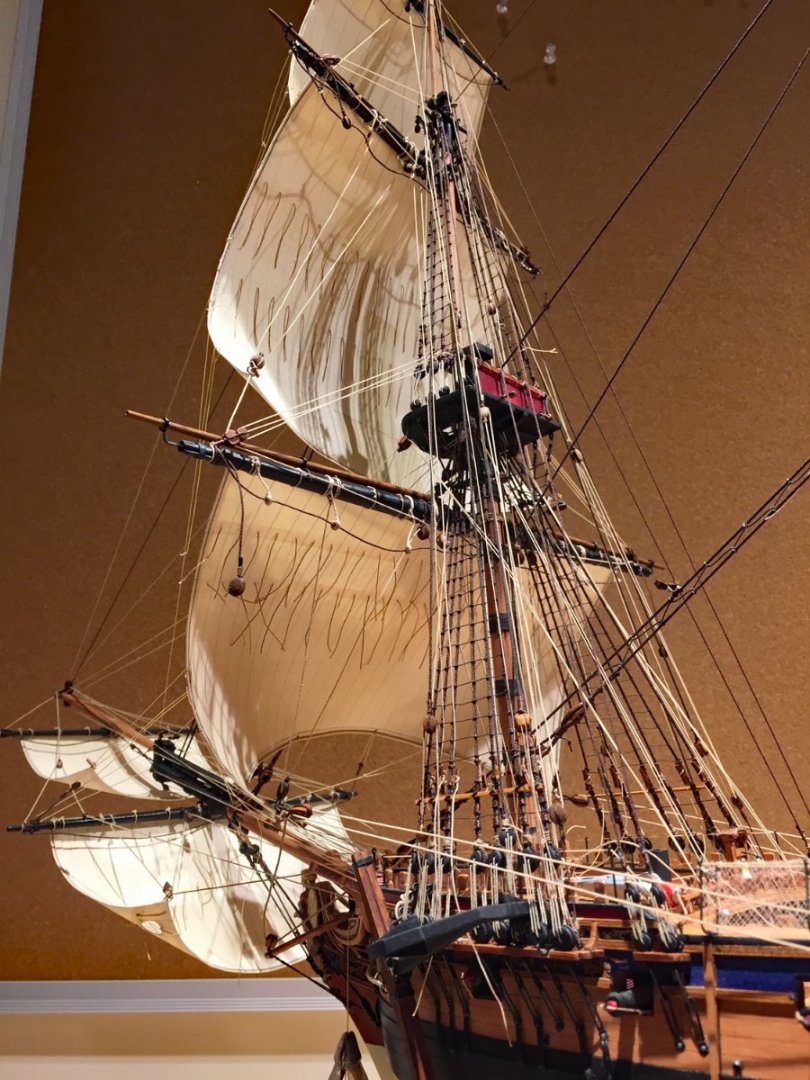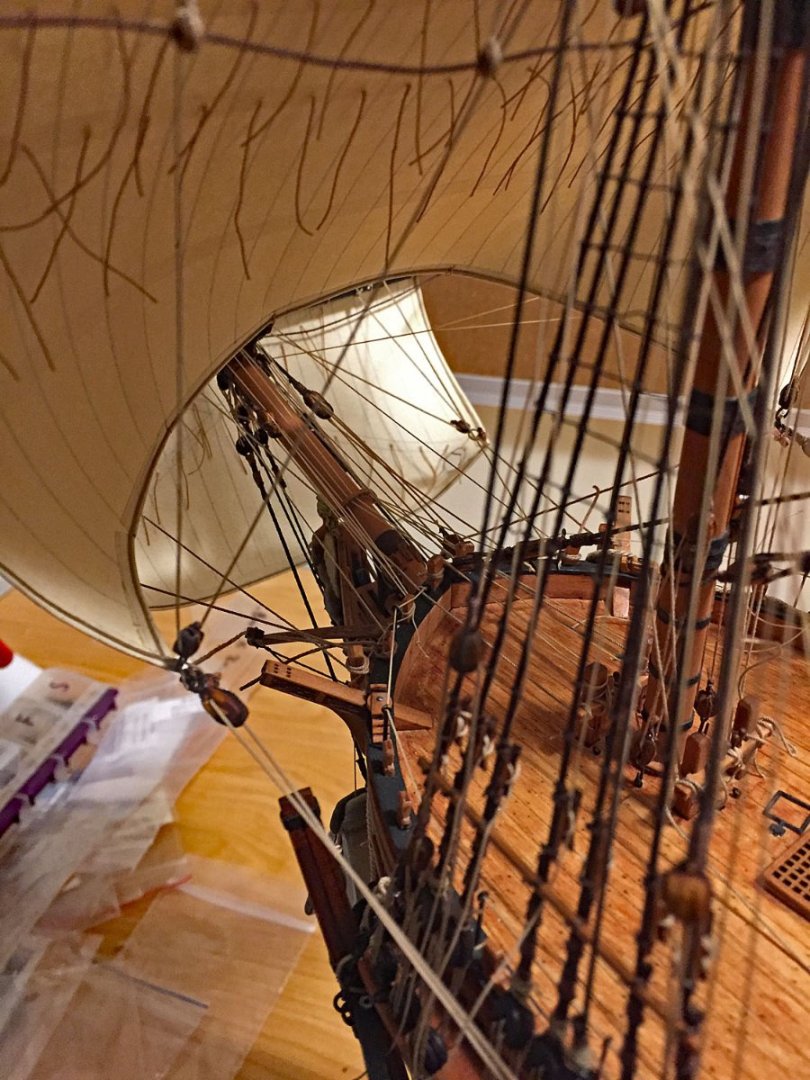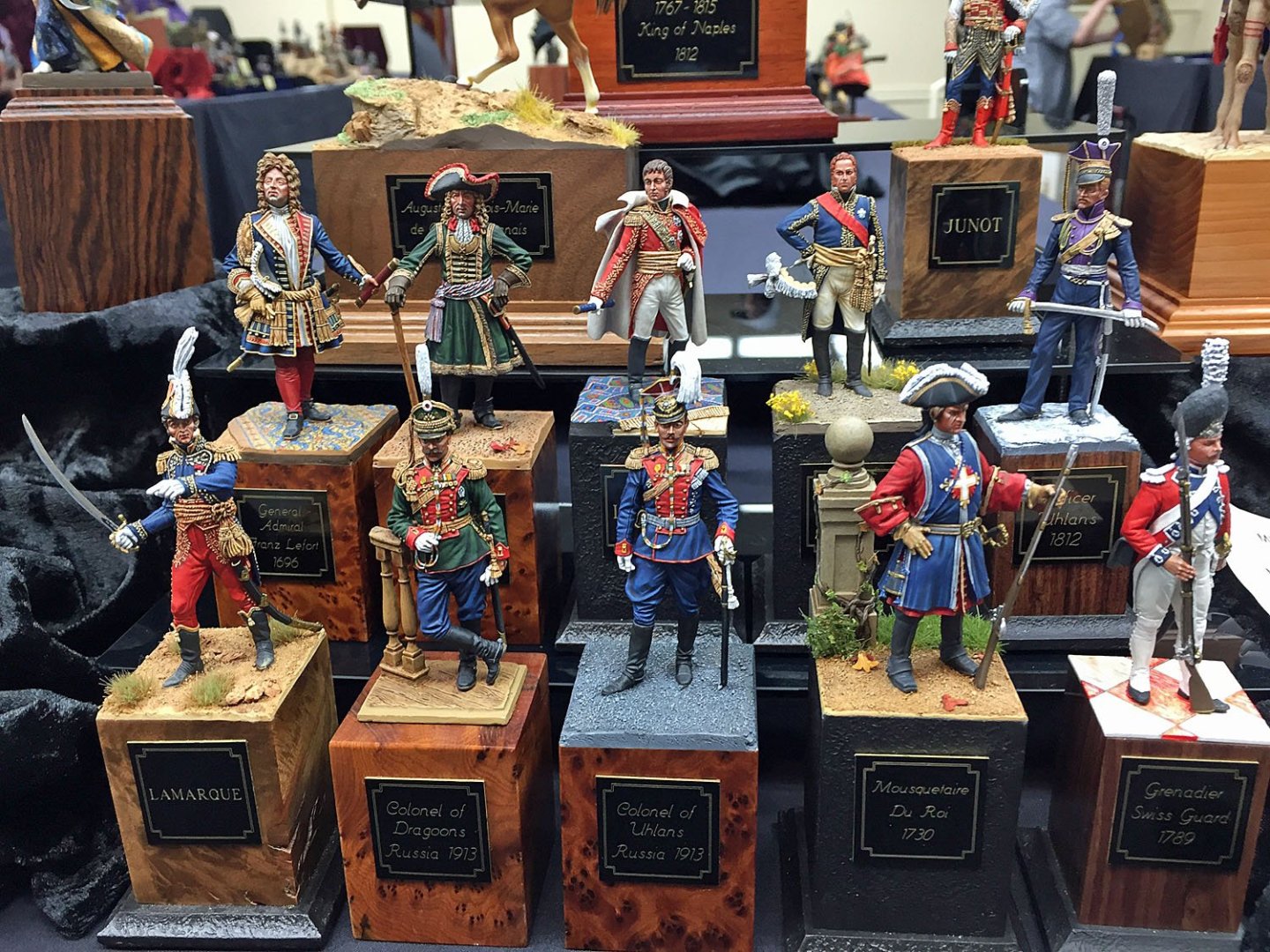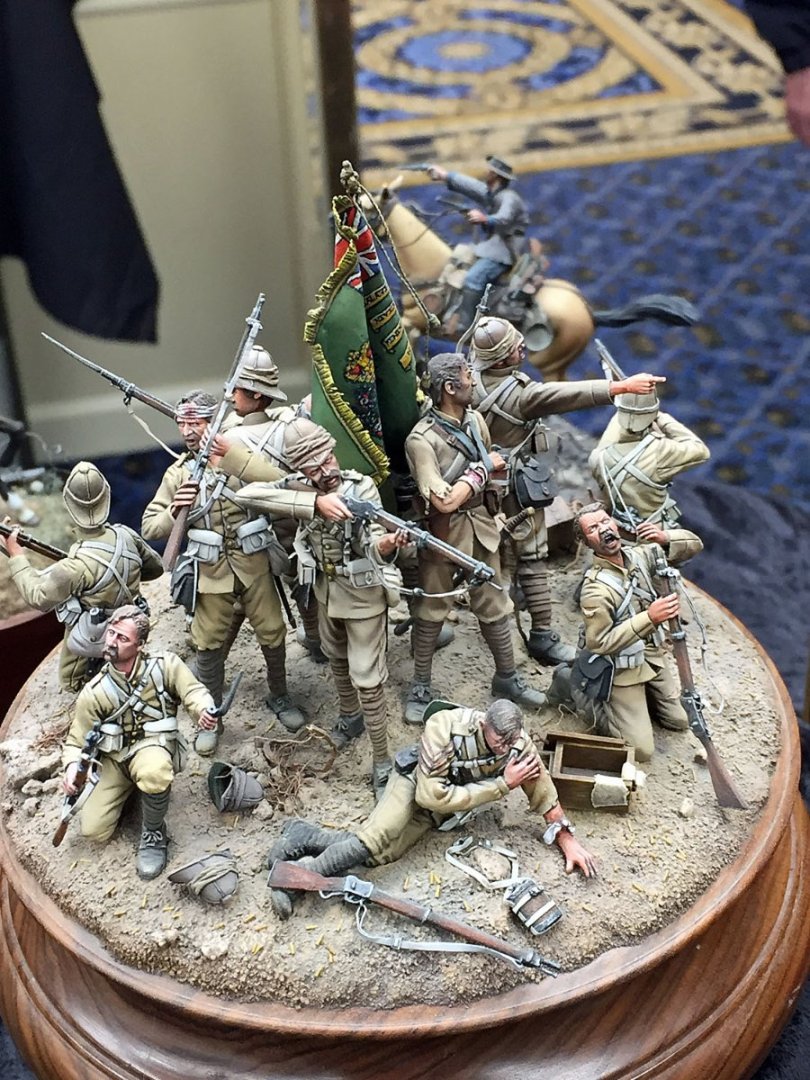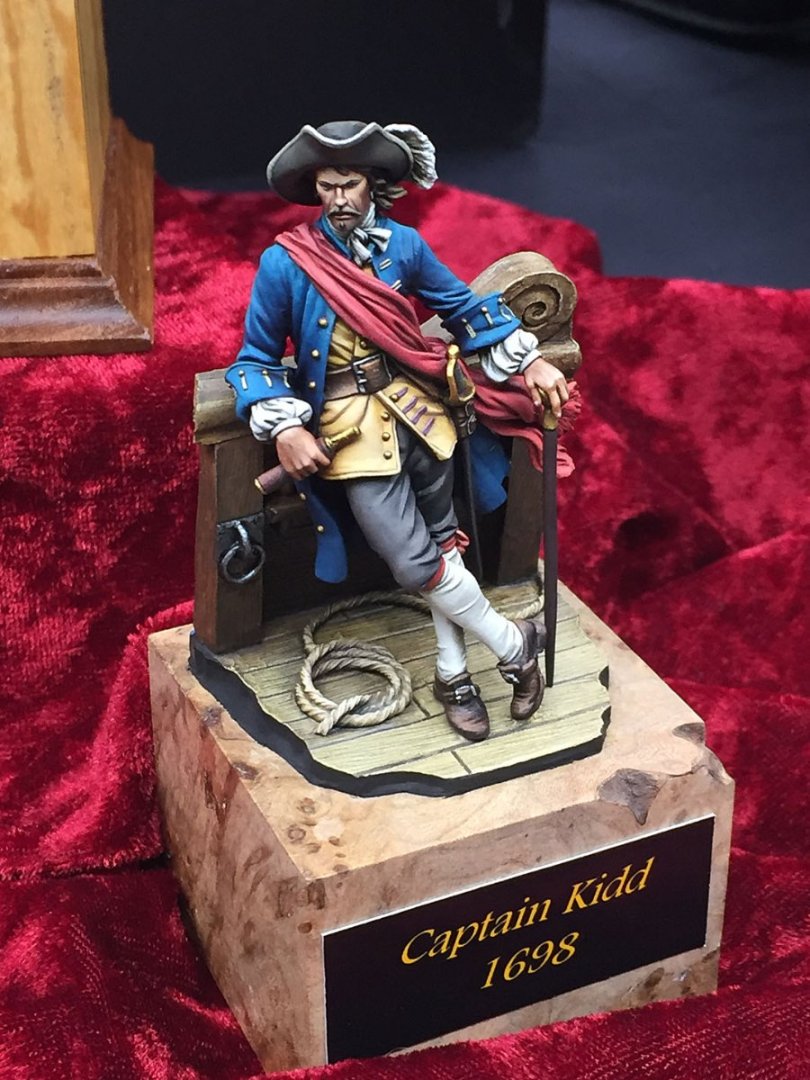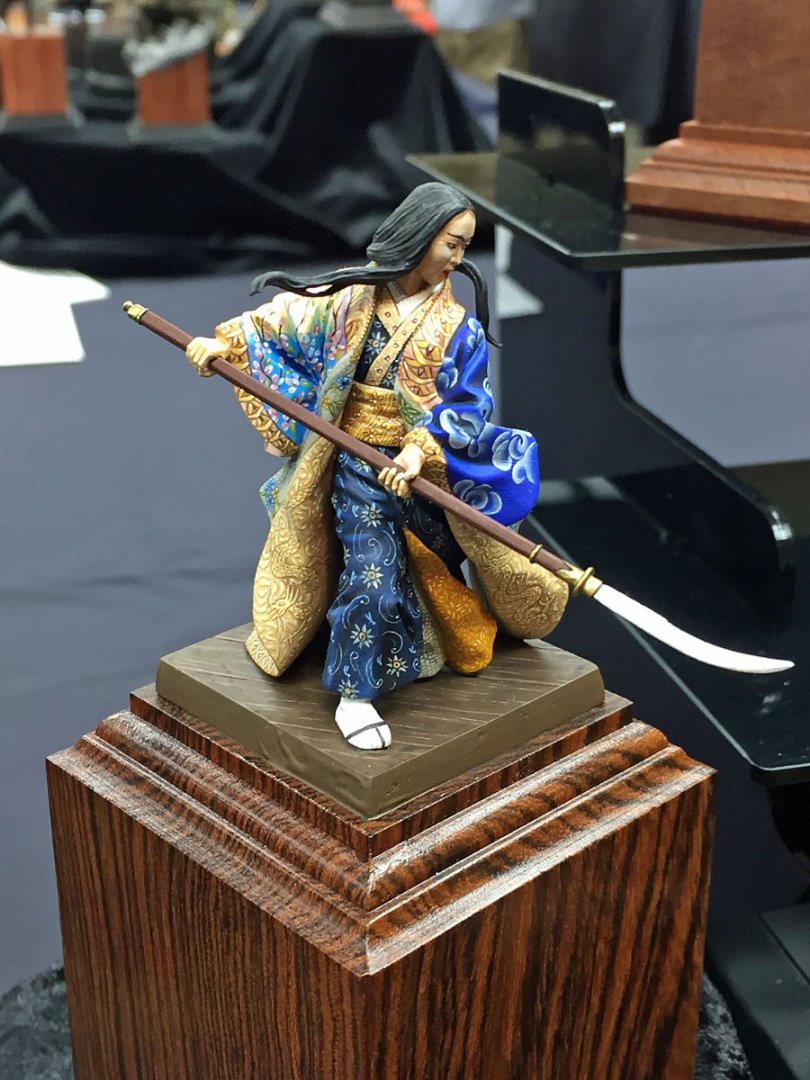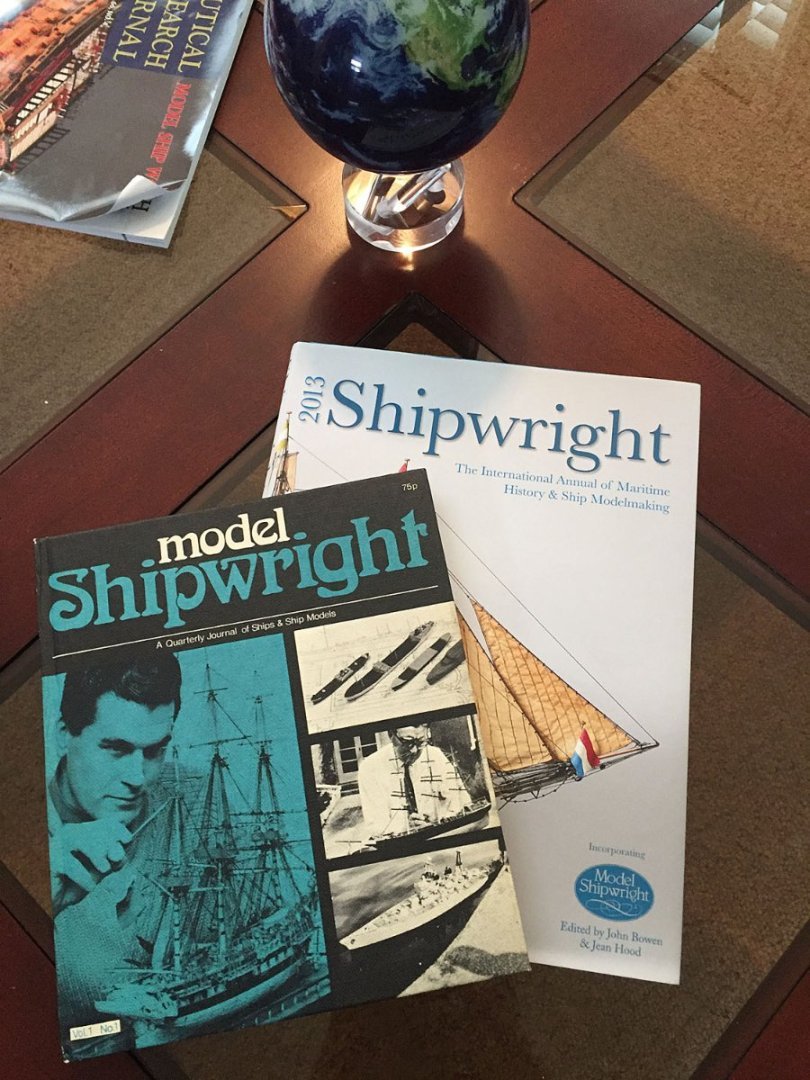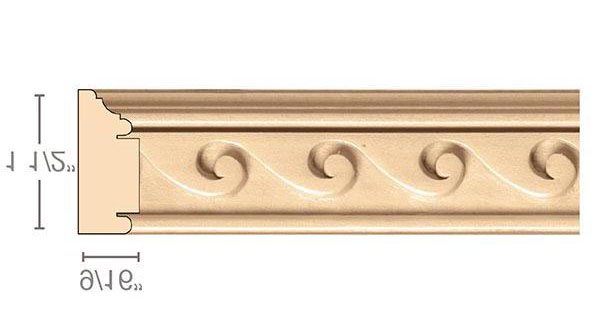-
Posts
1,589 -
Joined
-
Last visited
Content Type
Profiles
Forums
Gallery
Events
Everything posted by hollowneck
-
Small update: yet another diversion from my sail mounting... I've removed the anchor lines (hawse ropes) from Camilla due to her inclusion in a diorama on an "action chase." I'll fit her with a variation of what I did several years ago for my model of HMS Ardent (64) shown below. The "stoppers" in her bow's hawse rope openings were called "Hawse Bucklers." I haven't yet discovered a detailed explanation of how these were constructed but I imagine they had to have a suitable mechanism that allowed them to be released from inside the ship and that they had to be quite water-tight to be effective: sort of like a big cork that could be easily pushed out to clear the way for a big, fat rope. My photo also shows a lead sheath that protected the stem's cutwater. Ships that were anticipated to be in action had to protect this area as there was often lots of floating bits encountered that could damage the hull if not protected. Aside: Ardent's coppering has taken on a nice brown patina after 8 years of oxidation. I could touch-up some of the shiny bits with a weathering chemical to even out the look but I've got a few other items on my modeling punch list at the moment...
- 542 replies
-
- Sphinx
- Vanguard Models
-
(and 3 more)
Tagged with:
-
Thanks, Thomas. Making realistic-looking sails and then figuring-out how and to mount them is a lot of fiddly and arduous work I must admit: there is nearly as much work involved to add working sails as the entirety of all the other basic rigging. Of course, I could have chosen to not make a diorama as these certainly demand realism IMHO. There's an appropriate English saying: "Horse For Courses..." There are several definitions of this but the one I like is "what is suitable for one person may not suit another."
- 542 replies
-
- Sphinx
- Vanguard Models
-
(and 3 more)
Tagged with:
-
Wow. Nice diorama, Mike! I'm also a "figures-on-model" guy, so Congrats on this nicely-executed detail too. The most convincing funnel smoke I've seen on any ship model - particularly ones of the WWI & II eras is made from... wait for it....cat hair. An excellent scratch modeler from my former club models ships that have propulsion from things other than the wind and has a large, furry breed of a cat (Himilayan?) that sheds. He told our members he just snatches a hank when he needs it without describing exactly how the acquisition method happens...from the couch? While she/he sleeps? Very nice model, Looks like you had fun building this one that also didn't take two years to complete!!
-
Rusty, either would be an epic build and the "next step" for a superb kit. Keep a keen weather eye on the £-to-$ exchange rate, currently about 1£ = $1.09. This is almost parity and is a nominal 20% "discount" on the previous and long-standing rate between the two countries. I believe that by the time Indy is actually available (late Winter, early Spring 23), the rate will be close to "dollars-for-pounds" - as the English say. Chris has already indicated a price range that's going to hover around £1,100-1,200. If this is true, it could be the most expensive kit ever introduced to the hobby (am I wrong?). Life is a lot about timing- and luck. The former is something we can control.
- 201 replies
-
- Duchess of Kingston
- Vanguard Models
-
(and 1 more)
Tagged with:
-
The epic film, “Master & Commander” is still a touchstone for a realistic depiction of fighting sail at the end of the 17th-early 18th-century. Personally, I return to watch it every so often for an immersion in history related to our hobby (and the era) I love. The current Vic’s captain’s quarters in Portsmouth looks very “sanitary” by comparison. This First Rate’s spacious quarters looks like a high school cafeteria space compared with the stingy and head-banging spaces of most other fighting ships in the Age of Sail.
- 488 replies
-
- Indefatigable
- Vanguard Models
-
(and 1 more)
Tagged with:
-
The Metaverse rules! The evolving DIY anchors- MDF and 3D resin. I’ll make an assumption that Indy will offer a set of 3D anchors, Si’? Will you be offering 3D versions a la carte? Different sizes & scales?
- 857 replies
-
- Sphinx
- Vanguard Models
-
(and 1 more)
Tagged with:
-
Many thanks, B.E., your info and the pics are very helpful. I don’t have the Harland book but I believe there is someone in my club from whom I can borrow a copy. I have fitted hawse stoppers on a previous model so I’m familiar with how to bash a set of them. Removing the anchor cables on Camilla will be the easier part!
- 857 replies
-
- Sphinx
- Vanguard Models
-
(and 1 more)
Tagged with:
-
Thank you gentlemen. If I can get this sail to look the way I'd like, I believe showing a sail in this working configuration will add some "zing" to Camilla's chase in the Channel... Here is today's progress update on rigging the clues and shaping the sail's foot. Also, a quick reconnoiter on the crucial bunt lines that will cinch-up the middle section of the sail. A look at the Mainsail from starboard. All the sail's robands have been laced and tied-off to the main yard. The clue, sheet and tacks are rigged with the sail's corner leech brailed in. The port side of the Mainsail in a trial position for the clue, sheet and tack lines. The loose foot of the sail will be finessed upward once the bunt lines start to cinch up the middle of the sail. A view from the bow on the partially-shaped and positioned Mainsail. Clues and sheets, port and starboard, are rigged. Tacks will be added after the bunt lines are rigged. I'm pleased the translucency of this sail is visually quite similar to the much thicker topsail above it. I was a little concerned that using only a single layer of silkspan on this sail would make it too translucent. The folds and "bunching" effect diminishes the difference between this sail and the layered, fully billowing ones, particularly the topsail above it. The arrow points to a port bunt line that is hauling up the center portion of the sail. A closer look of the effect of the center bunt lines on the sail. The foot has "turned turtle here;" I'll use some adroit finger manipulation to reshape this portion of the sail into a more convincing presentation. The two bunt lines will require additional single blocks on the main top, similar to the ones I added to the foretop. I'm not sure where the bunt line falls will belay but this isn't a big issue...however, squeezing another set of 3mm blocks into a very tight rigging space is a little disconcerting at this late stage...but as the saying goes: "Don't Give Up The Ship!"
- 542 replies
-
- Sphinx
- Vanguard Models
-
(and 3 more)
Tagged with:
-
The last sail and its rigging... There will be a couple installments to this post as this last sail gets pre-made and then mounted to its yard. Hopefully, I'll be able to carefully fashion it into an acceptable shape resembling a "dangling sail." After studying many 17th & early 18th century ship paintings (the photographs of the era), I decided to bend a hauled mainsail to Camilla's main course yard. I then tossed a full working sail into the waste basket that I'd made previously. I had also considered creating a fully-furled one, gasketed tightly to the largest yard on the ship before deciding to try something different. Since my model shows her with a majority of her sails deployed and "at sea and in action" I decided to mount the partially brailed large sail across her midships. So many of the paintings I studied for reference showed this particular sail in this state (in many cases, also the foresail), especially in sea actions. I concluded that rarely would a patrolling ship have furled sails unless they were headed into very foul weather, anchored or in safe harbor. Starting from scratch, I've created a main course sail with a single layer of silkspan, unlike her 10 other layered sails. This overall piece is roughly half the size (vertically) of a full sail. and is the full width of it's corresponding yard. The single thickness of silkspan will allow me to more easily shape it and then apply a fixative to the resulting folds to show a loosened sail, ready to be quickly hauled when needed. I liked the whole idea of this working sail ready-to-go, rather than one constrained. I've made furled sails but I've never attempted to create a partially hauled and brailed one. We'll see how this turns out! To a single layer of previously colored silkspan (a leftover from Camilla's previous sailmaking), I carefully drew cloth panel lines in pencil to only one side (bow facing) and then added reinforcing tablings to the head and to a central portion of the foot. The roband ropes were added to the head and two holes for the bunt line cringles were added to the foot. To a portion of the foot and fully along the leeches I added a boltrope and the clue cringles as these will be prominently seen once the sail is in position. I anticipated the tabling reinforcements would be important as a single layer of silkspan would be subject to tearing and ripping easily with extensive finger manipulations to come at a subsequent mounting stage. The sail's corners are folded over to show the approximate position of these clue corners once the sail is bent. The walnut dowel (from the kit) is shown simply for scale reference and is about the actual diameter of the main yard. Camilla's Mainsail will be mounted here, rigged to its control lines and shaped to show a partially hauled sail.
- 542 replies
-
- Sphinx
- Vanguard Models
-
(and 3 more)
Tagged with:
-
Very nice job on the anchors, B.E. The MDF does finish acceptably if one is careful. Once you daub on some weathering powder, one will be hard-pressed to believe the "iron" is made from pressed wood scraps.I like your tapering of the pear stocks, what a good idea. I didn't catch this detail when I crafted my anchors. Placing anchors in your display case adjacent to your excellent model is a good, logical decision. I have a large bower anchor for my 64-gun model placed on it's display base near the bow and I routinely get questions about it usually regarding how large it is. Another option: you could put an anchor in one of the off-hull boats (just kidding). I'm still wondering how to achieve some realistic mounting details for HMS Camilla's bower anchors. There seems hardly any convenient spot to place these monsters anywhere near the catheads and/or fore channels. I haven't found much info about how this was accomplished in real life. Like much of the sail rigging I'm now doing, I'll come up with some "creative engineering" to solve my anchor placement issue.
- 857 replies
-
- Sphinx
- Vanguard Models
-
(and 1 more)
Tagged with:
-
Erdict, this advice from James H is quite important for a successful build of the Sphinx; it comes from the prototype engineer who works closely with Vanguard and writes the manuals. The stern counter is one of the most difficult areas to get properly aligned. You'll want to look into the Sphinx Build Logs of a couple members here to see the situation and how it's been handled.
-
As Blue Ensign said, this model kit is a fine one to build, very rewarding. This forum is an amazing resource for all model ship builders, novice and expert alike. In all likelihood if you can’t get a satisfactory answer here to any question, an answer likely doesn’t exist! Since this is not your first, you already know that a fun build isn’t a speed competition. Your time frame of 18-24 months is about right for steady work to a completely rigged Sphinx. Any tough spots you encounter, the answers will be here across several build logs for this superb kit. I’ll be looking in to your build as I complete mine over the next couple months. Welcome aboard, weigh anchor and set your heading…for success.
-
As promised, here's Camilla's recently arrived crew: two proper tars and six cannoneers (including a powder "monkey"). I will paint them over the next week or so when I'm needing another break from the final sail rigging details. These 1:64-scale 3D printed figures are impressive. The height of the figures is approximately 1” or 28 mm. Once painted, the detail on all the figures will make them come alive. I couldn't resist arraying them on the poop deck of my HMS Ardent (64). It's also 1:64 in scale and I wish I had these when I was finishing-up this build from 2014. I am tempted to possibly grab another set of sailors from Chris expressly for this model. A close-up view of Cpt Pennypincher and two Royal Navy "Tars." The bases will be removed; I'll use either a Dremel or even a disc sander to remove them so they all will stand on their feet properly. This photo’s color is reasonably accurate for the unpainted resin. The shirtless and shoeless "powder monkey." The dashing sailor with hat, jacket and kerchief. I need to do a little research on late 18th-C sailor garb before cracking open the paint jars. Captain Pennypincher stands along side a female Grey Whale and her calf. After completing the above model I wanted to give some indication of scale and there simply were no good, accurately-sized figures available at that time. I searched for the next closest thing which - as it turned-out- wasn’t perfect yet helped to convey the enormity of the vessel: the whales are reasonably scale accurate to the ship. The Pegasus serpent pedestals? Not so much... I haven't decided WHERE I'm going to place my minimalist crew on Camilla. Perhaps on her stern q'deck, like I've shown here. The cannon crew is for a long cannon, not a carronade, so this position may not work for the six figures. We'll see...
- 542 replies
-
- Sphinx
- Vanguard Models
-
(and 3 more)
Tagged with:
-
I omitted the miniscule base flanges entirely; not necessary. These also didn't allow a clean fit from the crane's end. I used a tiny drop of CA on the end and pre-drilled the bulwark holes that weren't large enough to accommodate them easily. These kind of felt like an afterthought, however I added them - and their ropes - afterall. They mount very tightly and right up against the shrouds. I painted mine flat black and added a little metallic weathering powder to turn them into iron. Make sure to file off the brass P/E "sprue" nubs.
- 857 replies
-
- Sphinx
- Vanguard Models
-
(and 1 more)
Tagged with:
-
Thank you, Nipper, your comments much appreciated. Should you choose to have your Sphinx harness the wind, I hope you’ll be able to glean some details from my photos and techniques that might make the task rewarding- and fun. Notice I didn’t include the word “challenging,” as I suspect you already are aware of this…
- 542 replies
-
- Sphinx
- Vanguard Models
-
(and 3 more)
Tagged with:
-
Thanks, druxey. Having had all the “protections” I have no idea how the sneaky virus made it through my layers of antigens! I am feeling so much better now and besides, the virus has no idea how many more models I am determined to build!
- 542 replies
-
- Sphinx
- Vanguard Models
-
(and 3 more)
Tagged with:
-
Thanks, B.E., as anyone who has also experienced this indicates, it’s no fun. Symptoms can run the gamut of unpleasantness. Your Sphinx is looking beautiful and I wholly agree that your superb little boats will look perfect, “de-cluttered” from the ship’s skids. Congratulations.
- 542 replies
-
- Sphinx
- Vanguard Models
-
(and 3 more)
Tagged with:
-
After a nearly three week hiatus - and having dealt with The Plague (Covid's latest variant) - I was back in the shop this past week. And finally felt like a human. It's good to be back - even with attenuated shop time - working on the final stages of my HMS Camilla (now King Charles' Consort!). God Save The King. Obviously, I'm also pleased to be sitting in front of my computer once again, posting photos and some text on this Build Log. It's also good to still be around after a mean bout...I've had all my multiple inoculations, but it still laid me low for a while. Here's a photo update of last week's progress on sail rigging. The Big Picture: nearly all sail rigging lines have been completed: clues, sheets, bunt and bowlines. The Mizzen topgallant is skewed and needs tweaking. Once the sail rigging is finished, the rigging clips that temporarily secure the lines get removed as the tension from starboard-to-port or bow-to-stern gets properly balanced. Once this is completed, then I'll make numerous rope coils for the belaying and cleat positions. The coils will be carefully positioned and then glued with Liquitex matte adhesive. All the sails have been "shaped" to show them as working sails; I also refer to these now as "set" sails. The sails will be have some dry-brush painted "weathering" effects added once their final positions are secured. More on this to follow. A view of the foremast with all her sails. The bowmast (bowsprit) has two spritsails, a first for me. This sail rigging was a little tricky as I've found scant information on where the sail management lines belay. It's a very tight fit in the foc'sle for all the necessary lines. I had to add additional blocks and cleats to accommodate some of these lines. Another view of the sails on the foremast from midships. It's a tight fit at the foc'sle's stem! Running and sail rig lines at the jeers have yet to be secured. I do attach these with CA glue after they're properly tensioned and trimmed-off. Once appropriate rope coils/hanks are positioned, they hide the CA glue terminated falls. I haven't determined the placement for block & tackle on the spanker (gaff-mounted) mizzen sail. I'm researching how and where to secure this particular sail, hence the large clamp holding it in temporary position. Keen eyes will see that the main course carries no working sail; I'm fashioning a furled sail from silkspan only for this yard. The sail will be "foreshortened" and hauled to the yard with her buntlines and clues, and lashed to the yard. Unlike all her other sails, This sail will not have a core of bond paper as it isn't necessary and would be extremely difficult to fashion properly with the stiffness of the paper between silkspan layers. This will be the final sail to be mounted because I needed unhampered access to the mid-deck belaying points at the jeers and cleats. Those who have been closely following my log will note that I’ve changed my mind on how to treat the large main course sail: I’ve wavered between: A. Omitting it entirely, concerned somewhat with what it visually hides of deck detail, B. Mounting a full working, billowing sail, or - C. A furled sail that hides only small details of it’s yard but completes the ship’s main, full complement of sails (minus staysails). As I’ve previously mentioned, I originally planned to add stunsails - the ones extended from the ends of the main courses and top yards - but these would have made the size of the overall model especially unmanageable in a diorama. The starboard view of the fore deck. Those fore course and foretop sails are responding to a strong wind blowing across her open midships. Anyone who has sailed in a stiff wind knows that sails can take on dramatic shapes when they're closely hauled against the prevailing wind. Another starboard view; a few braces and a couple clue lines for the topgallants and foretop are still on my check list. I will note for others who may desire to add sails to this excellent kit that there is no sail plan included. Reference materials are available however, even these don’t deal with some of the realities of final ship configurations, especially on how and where the rigging lines were terminated. I consider this “creative problem-solving”, an exercise that some modelers won’t have the slightest interest in pursuing… BREAKING NEWS I just received the rest of Camilla’s “crew” who just arrived by Royal Mail (&USPS) from the U.K. In addition to Cpt. Pennypincher, there will be a full cannon team as well as a couple sailors recruited from Vanguard’s 3D printer in 1:64-scale…photos to come. Soon.
- 542 replies
-
- Sphinx
- Vanguard Models
-
(and 3 more)
Tagged with:
-
I'm excited to see Larry's work on Chris' new Royal Navy figures. I've ordered a couple of the sailors and a cannon crew from Vanguard and plan to add them to my latest model/diorama. This April, I went to a local Exhibit/Conference in PA that's sponsored by the MFCA (Miniature Figure Collectors of America - link: https://www.mfcaclub.com/). Who knew this existed! This is also a large collectible international hobby. I was impressed with the extraordinary quality of the figures with a wide variety of subjects and scales: all superbly sculpted, painted and displayed. Serious collectors pay MUCHO $ for some of these. Many of the artists with whom I spoke were from Europe. One creator (from Spain) told me he works on commission only and can take up to a year to craft a single figure. Here are a couple photos (of many!) of this artistry. When I inquired about this Warrior Geisha, the artist told me I could have it on a "Show Special" price for $4,000. After a few conversations, I stopped asking artists how much they were asking for their creations... I recall the scale here was 1:35. Many plastic military modelers work in this "standard scale." The presentation stands are equally impressive IMHO. Exotic, burled and polished hardwoods mostly. In addition to creating custom "sculpts" for collector clients, some artists license their figures for resellers who make the unpainted figures available for mere modeling mortals...
-
Superb job, Rusty. Congratulations. Having personally seen your models up-close these last few years, I can attest that your work is an excellent example of high-quality craftsmanship combined with a good quality kit! I can highly recommend Vanguard's HMS Sphinx kit. It's the "next level" for high-end kits IMHO. Lot's of innovation and excellent materials and extensive plans. Also, the next large kit from Vanguard will be the HMS Indefatigible, an (in)famous 64. It won't likely be available until next year. It's on my short list.
- 201 replies
-
- Duchess of Kingston
- Vanguard Models
-
(and 1 more)
Tagged with:
-
Chris, thanks for taking the time to share photos of your growing business. Big machines. Bigger essential wood inventory! Glenn is correct that in good time you’ll need to have a larger “factory.” I especially liked the photo of the row of printed figures on the shelf. I’m excited to paint my Vanguard/HMS Camilla gun crew, place them on-deck in a few weeks when I christen her launch with my Cpt. Pennypincher.
-
I just realized the second photo in my last post (carved wood section) may be slightly obscure without better context. I'm starting to lean into the design steps of my diorama here because these considerations are critical to how I approach making water depictions. I believe several MSWer's will be interested in this step as well as the actual water making steps and materials. I still have lots to accomplish with my sail rigging, but for the most part this has been explained in quite some detail. My next updates will show completed "sections" with their finalized sails and their extensive rigging (Fore, Main, Mizzen, etc.). Looking ahead... Here are a couple photos showing a prepared base where I've placed my completed model(s) temporarily into a shallow "pan" of custom architectural millwork. You can see the custom sides of the case, the plywood bottom and attachment blocks that fasten the mill-worked sides to the base. In this instance, the depth of the case to contain the ship and its diorama was only 1 inch (after attaching the 1/2" ply base). In contrast, the sides for HMS Camilla's diorama will be 4" high, mainly for the subsequent creation of a turbulent sea with large wave action but also to have enough "depth" to accommodate the model's hull. These photos are from my last diorama project that features an 18th-C Japanese village being visited by a cargo ship delivering supplies. There are photos of this completed model diorama in my gallery; The ship model is nearly complete (there was additional rigging to be added). In the background is model of a Japanese teahouse that was included. I had an idea of what I wanted to see as a completed setting but everything didn't come together until I started depicting a shoreline and landforms. The rice bales and the figure were key to my final vision of the ship's "mission." This is a graphic of the millwork section that I used for the sides of this "Takes A Village" diorama. I'll acquire the 4" high casing millwork from the same vendor for my Camilla diorama. This graphic is chair rail molding and it will be turned upside-down for the case sides. I plan to do the same thing with the door casing millwork for Camilla's base. You can see that the height of the chair rail molding is only 1.5". The sides for Camilla's base will be 4" high; the sides will also need to allow for an inside measurement that is less the thickness of the plywood base (1/2"- maybe 3/4"), similar to my other diorama depictions.
- 542 replies
-
- Sphinx
- Vanguard Models
-
(and 3 more)
Tagged with:
-
I was slightly startled to see the telltale "baby's first month" yellowy/beige background color on the commentary (read: "criticism") about your planking decision for Indy. Yep, lot's of experts over there, but no expertise.
- 488 replies
-
- Indefatigable
- Vanguard Models
-
(and 1 more)
Tagged with:
About us
Modelshipworld - Advancing Ship Modeling through Research
SSL Secured
Your security is important for us so this Website is SSL-Secured
NRG Mailing Address
Nautical Research Guild
237 South Lincoln Street
Westmont IL, 60559-1917
Model Ship World ® and the MSW logo are Registered Trademarks, and belong to the Nautical Research Guild (United States Patent and Trademark Office: No. 6,929,264 & No. 6,929,274, registered Dec. 20, 2022)
Helpful Links
About the NRG
If you enjoy building ship models that are historically accurate as well as beautiful, then The Nautical Research Guild (NRG) is just right for you.
The Guild is a non-profit educational organization whose mission is to “Advance Ship Modeling Through Research”. We provide support to our members in their efforts to raise the quality of their model ships.
The Nautical Research Guild has published our world-renowned quarterly magazine, The Nautical Research Journal, since 1955. The pages of the Journal are full of articles by accomplished ship modelers who show you how they create those exquisite details on their models, and by maritime historians who show you the correct details to build. The Journal is available in both print and digital editions. Go to the NRG web site (www.thenrg.org) to download a complimentary digital copy of the Journal. The NRG also publishes plan sets, books and compilations of back issues of the Journal and the former Ships in Scale and Model Ship Builder magazines.

